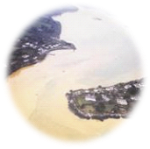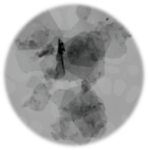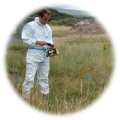____________________________________
Industrial Liaison Group:
Tel: +44 (0) 1235 778797
E-mail: industry@diamond.ac.uk
Removing environmental contaminants such as heavy metals from polluted water systems is a problem across the globe. New advanced materials are needed that can prevent pollution and “clean up” existing contaminated environments. Green rust (GR) compounds are a unique class of materials which form in natural environments and can be synthesised in the laboratory. The unique structure and chemistry of GR nanoparticles means that these phases can chemically transform (reduce) and immobilise many toxic metals such as chromium and uranium. This process can significantly reduce the bioavailability of the contaminants.
There is increasing interest in GRs as materials for environmental remediation, however the formation and stability of GR is not well understood. Green rust is extremely air sensitive and can transform into other phases within seconds if exposed to oxygen in air. To monitor the formation of green rust and it’s behaviour under environmental conditions, measurements need to be performed in a highly controlled environment (e.g. oxygen-free). Also, analysis of the GR needs to be performed while the particles are forming from solution.
I22 at Diamond is a beamline ideally suited to studying the formation of nanoparticles as it can measure length scales in the range of a few angstroms up to 250 nm coupled with time resolution of sub-milliseconds. The data collected on the beamline has been used to understand the kinetics and mechanisms of particle nucleation and growth under challenging experimental conditions (a wet, oxygen free environment).
The experiments provided an understanding of the key parameters involved in the formation and stability of GR. Optimisation of the reaction conditions, based on these results, allows the development of new pollution prevention technologies and could inform the design of new remediation technologies to clean up existing contaminated environments.




“Diamond is enabling us carry out our experiments incredibly fast, and effectively allows us to bring the contaminated land site onto the beamline. This means that we are, for the first time, seeing exactly how the green rust is effecting the toxic and radioactive species in the soil. On the beamline, we can do in one day what it would take years for us to achieve back in the laboratory. This may bring the reality of a green rust remediation technology within our grasp within years.”
Dr Sam Shaw, University of Leeds

Formation of green rust sulfate: A combined in situ time-resolved X-ray scattering and electrochemical study. I. Ahmed, L. Benning, G. Kakonyi, A. Sumoondur, N. Terrill, S. Shaw, Langmuir, 26(9), 6593-6603 (2010) (DOI:10.1021/la903935j)
Diamond Light Source is the UK's national synchrotron science facility, located at the Harwell Science and Innovation Campus in Oxfordshire.
Copyright © 2022 Diamond Light Source
Diamond Light Source Ltd
Diamond House
Harwell Science & Innovation Campus
Didcot
Oxfordshire
OX11 0DE
Diamond Light Source® and the Diamond logo are registered trademarks of Diamond Light Source Ltd
Registered in England and Wales at Diamond House, Harwell Science and Innovation Campus, Didcot, Oxfordshire, OX11 0DE, United Kingdom. Company number: 4375679. VAT number: 287 461 957. Economic Operators Registration and Identification (EORI) number: GB287461957003.